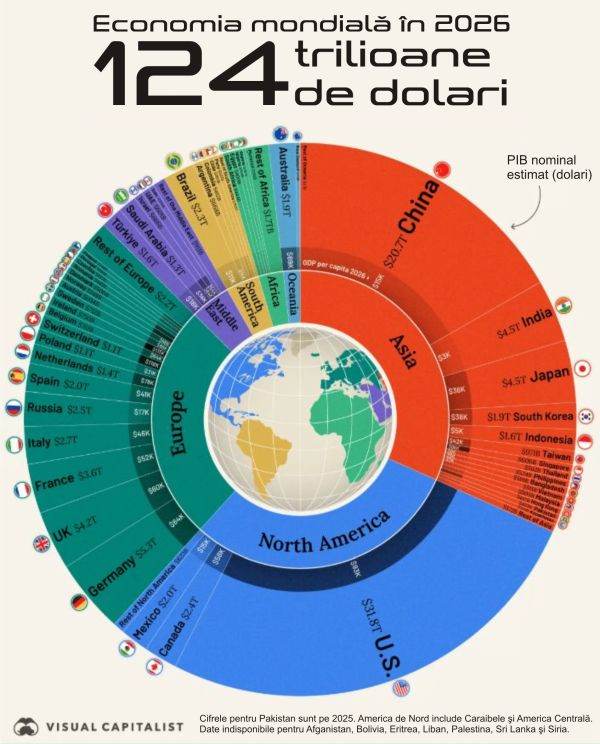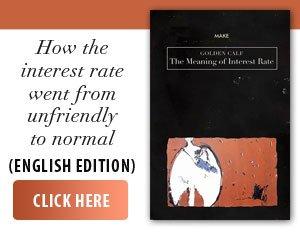The outlook for the world economy in 2026 is cautious, according to a report published this month by the International Monetary Fund (IMF), which shows that the global expansion is slowing due to fragmentation and rising protectionism. There are significant downside risks, from a potential revaluation of technology company shares to the erosion of institutional independence, which could weaken political decisions, according to the cited source.
A visualcapitalist.com analysis brings to attention these aspects, namely the evolution of each country's GDP, using the projections for 2026 released by the IMF.
• USA - the world's largest economy for a hundred years
The United States has been the world's largest economy for the past 100 years, and according to the cited source, the question arises as to whether it is possible to maintain this position for the next 100 years. Expectations show that the American economy will reach a GDP of $31.8 trillion in 2026, with a somewhat resilient labor market and continued consumer spending supporting this dominance. However, growth estimates were revised downward after October 2024, after trade wars shook global markets and generated price increases for the world's largest consumer economy.
Meanwhile, China's GDP is projected at about $20.7 trillion, 35 percent smaller than the U.S. total, but still three times larger than Germany's ($5.3 trillion), ranked third.
Structural headwinds to U.S. growth - from an aging population to a stagnant housing market - are holding GDP growth to 4 percent, the slowest multi-year pace in four decades, the source said. Further disruptions from tariffs on Chinese goods will also hit the world's largest export sector.
India ($4.5 trillion) is on track to hold onto fourth place, having overtaken Japan in 2025, helped by domestic demand. On the other hand, Indonesia and Turkey are climbing the rankings, highlighting the demographic advantage and political reforms of many middle-income nations.
The 5th to 10th places in the top of the world's largest economies are as follows: Japan ($4.4 trillion), the United Kingdom ($4.2 trillion), France ($3.5 trillion), Italy ($2.7 trillion), Russia ($2.5 trillion), Canada ($2.4 trillion).
• Asia - the world's largest economic region
Asia surpasses North America as the world's largest economic region, with a GDP in 2026 of $39.1 trillion, compared to $37.1 trillion, the cited source notes. With countries such as China, Japan and India, the region has a slight advantage over the US and Canada. Europe ranks third in terms of global GDP, with $31.6 trillion, followed by the Middle East ($5.4 trillion), South America ($4.5 trillion), Africa ($3.3 trillion), and finally Oceania ($2.3 trillion). Global GDP is estimated by the IMF to be $123.6 trillion in 2026.
• Top 3 by GDP per capita: Luxembourg, Ireland, Switzerland
The top 3 countries with the highest estimated incomes for 2026 (by GDP per capita) also remain unchanged, according to the IMF: Luxembourg ($154,115), Ireland ($135,247), and Switzerland ($118,173). All three countries benefit from significant foreign capital inflows, which boost their economies relative to their populations. In particular, European countries occupy half of the top 20 places in the ranking, indicating the general standard of living in the region. In places 4-10 we find: Iceland ($108,591), Singapore ($99,042), Norway ($96,580), USA ($92,883), Denmark ($82,706), Netherlands ($77,881), Macau ($77,443). Places 11-20 look like this in the IMF forecast: Qatar ($76,534), San Marino ($69,493), Australia ($69,358), Sweden ($66,124), Austria ($65,640), Israel ($64,275), Belgium ($63,896), Germany ($63,600), UK ($60,011), Finland ($59,750).
At the other extreme, 17 African countries are in the top 20 poorest nations by GDP per capita. The poorest country is South Sudan ($369), followed by Yemen ($401), Burundi ($618), the Central African Republic ($651) and Madagascar ($653).















































